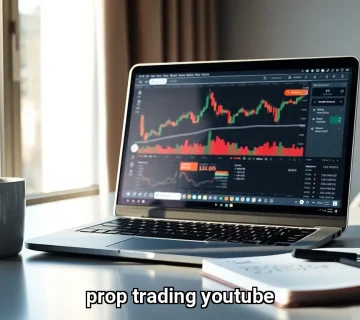In the fast-paced world of finance, the prop trading business model stands out as a dynamic approach that offers both opportunities and challenges for traders. Unlike traditional investment strategies that depend on client funds, Propx Pro and other prop trading firms utilize their own capital to engage in market activities, aiming to maximize profits while effectively managing risk. This self-funded structure enables firms to explore diverse revenue models, including spreads, commission-based systems, and performance fees—all designed to align the interests of traders and the firm. At Propx Pro, traders benefit from a well-structured model that fosters growth, innovation, and financial success, making it an attractive choice for ambitious market participants.
But what truly sets proprietary trading apart is the potential for traders to access substantial capital and sophisticated resources, allowing them to execute larger trades and explore diverse strategies. Whether it’s trend-following or mean-reversion trading, understanding how to navigate these methods can dramatically influence a trader’s success. However, it’s essential to recognize that with great potential comes significant risk.
Market fluctuations, operational constraints, and regulatory considerations are all factors that traders must be prepared to tackle. The dynamic nature of financial markets means that traders must not only have a solid foundation of knowledge and skills but also be adaptable and ready to respond to unexpected challenges. Furthermore, the competitive landscape requires traders to continually refine their strategies and stay informed about market trends, technological advancements, and macroeconomic factors that can impact their trading performance.
If you’re intrigued by the inner workings of prop trading firms and eager to explore how to thrive in this competitive landscape, keep reading. Discover how to make informed decisions that could elevate your trading career to new heights. The journey into proprietary trading is not just about learning the mechanics of trading itself; it also involves understanding the various business models that prop firms employ, the risks inherent in trading, and the skills necessary to succeed in a rapidly changing environment. By arming yourself with knowledge about the industry, you can better position yourself for success and navigate the complexities of the prop trading world more effectively.

Prop Trading Business Model
The prop trading business model is an intriguing landscape within the financial markets, characterized by its unique structures and operational methodologies. Proprietary trading, commonly referred to as prop trading, involves firms trading financial instruments using their own capital rather than clients’ funds. This model is distinct from traditional investment banking practices, where traders are primarily executing trades on behalf of clients. In the realm of proprietary trading, firms prioritize maximizing their earnings while effectively managing risk. The flexibility to operate on their own terms allows these firms to engage in more strategic trading activities that can yield higher returns compared to conventional trading approaches.
Understanding the various revenue models adopted by prop trading firms is essential for grasping the intricacies of this business. Commonly, firms utilize the spread revenue model, which hinges on the difference between the buying (bid) and selling (ask) prices of assets. This margin serves as the profit for the firm on executed trades. Another prevalent approach is the commission-based revenue model, where firms charge commissions on each transaction.
This model is particularly favored by firms that allow their traders to operate using the firm’s capital, establishing a clear link between the firm’s profitability and the trader’s activity. This connection not only incentivizes traders to perform well but also encourages a collaborative environment where both the firm and its traders benefit from successful outcomes.
Moreover, the performance fee revenue model offers an enticing structure, where firms take a percentage of the profits generated by their traders. This model aligns interests between traders and the firm, fostering an environment where both parties benefit from successful trading outcomes. However, it is crucial for traders to analyze these models in relation to their own trading strategies, as the profitability of the firm can significantly impact the trader’s potential earnings. By understanding how these revenue models work, traders can make more informed decisions about which firms to join and how to tailor their trading strategies to maximize their earnings potential.
As firms strive for sustainability, many develop diversified revenue streams. By combining multiple revenue models — such as spread, commission, and performance fees — prop trading firms can stabilize their income and reduce reliance on any single source. This approach not only mitigates risk but also enhances the firm’s overall profitability. A well-rounded revenue strategy allows firms to weather market fluctuations and maintain a consistent income flow, which is essential for both the firm’s longevity and the traders’ livelihood. Consequently, traders should consider the revenue models utilized by potential prop firms when evaluating their options and selecting a trading environment that aligns with their financial goals.
Understanding Proprietary Trading
The intricacies of proprietary trading extend far beyond basic revenue generation. At its core, proprietary trading allows traders to leverage the firm’s capital and resources, enabling them to take on larger positions than they could independently. This is particularly advantageous for traders who have a solid grasp of market dynamics and wish to capitalize on their trading strategies without the constraints typically associated with retail trading. Having access to significant capital can amplify a trader’s potential returns, but it also requires a higher level of responsibility and risk management.
Proprietary trading firms can be categorized into various structures, with each offering different advantages and conditions. Traditional prop firms often operate on a profit-sharing basis, where traders retain a significant portion of the profits they generate. This structure motivates traders to perform at their best, knowing that their efforts will directly impact their earnings. On the other hand, Joint Back Office (JBO) structured firms may require traders to lock up their deposits for a certain period, adding a layer of commitment to the trading relationship.
This variance presents traders with options to select a firm that aligns with their financial goals and trading styles. Understanding these distinctions is crucial for traders looking to find a supportive environment that fosters their growth and development.
For instance, firms like Propx Pro provide various challenges and funding models, allowing traders to choose an option that best suits their expertise and risk appetite. Prospective traders should evaluate factors such as available assets, trading frequency, and the trading platform offered by the firm. This level of scrutiny is essential for ensuring that the chosen prop trading environment matches their trading preferences and enhances their potential for success. By taking the time to research and compare different firms, traders can make more informed decisions that could significantly impact their trading careers.
The Mechanics of Prop Trading
The mechanics of prop trading involve a delicate balance of risk management and capital allocation. Successful prop traders often employ sophisticated trading strategies, utilizing technical analysis and market research to inform their decisions. The trading environment in prop firms is typically fast-paced, requiring traders to remain vigilant and adaptable to market fluctuations. This dynamic nature demands that traders possess not only a strong foundational knowledge of trading principles but also the ability to think critically and make quick decisions under pressure.
One of the key advantages of prop trading is the access to substantial capital. Many firms offer significant leverage, enabling traders to amplify their potential returns. For example, some firms may provide up to 20-30 times leverage on a trader’s capital, allowing them to engage in larger trades than they could independently. However, this increased potential for profit comes with heightened risk; thus, effective risk management strategies are crucial. Traders must remain disciplined and adhere to their risk management protocols to avoid significant losses that can arise from over-leveraging.
Traders must not only focus on their trading strategies but also on how they manage their risk exposure. This includes establishing stop-loss orders, diversifying their portfolios, and continuously analyzing market conditions. Firms often provide tools and support to help traders navigate these challenges, enhancing their ability to make informed decisions. Additionally, regular training and access to educational resources can equip traders with the skills necessary to refine their strategies and improve their overall performance.
Furthermore, the structure of profit sharing can vary widely between prop firms. Traders might receive anywhere from 40% to 100% of their profits depending on the firm’s policies. Understanding the specific profit-sharing arrangements is vital for traders contemplating joining a prop firm, as it directly influences their income potential. A clear understanding of how profits are distributed can help traders set realistic financial goals and expectations, allowing them to plan their trading activities more effectively.

Profit Strategies in Proprietary Trading
In the competitive realm of proprietary trading, developing effective profit strategies is paramount for success. Traders often rely on a combination of technical analysis, market sentiment, and algorithmic trading to capitalize on market opportunities. The ability to interpret market signals and execute trades swiftly can distinguish successful traders from their peers. This requires not only a deep understanding of market trends but also a commitment to ongoing education and adaptation to changing market conditions.
One common strategy employed by prop traders is trend-following, which involves identifying and capitalizing on existing market trends. By analyzing price movements and market indicators, traders can make informed decisions about when to enter and exit positions. This strategy often requires a keen understanding of market momentum and the ability to react quickly to changing conditions. Traders who master this technique can significantly enhance their profitability by aligning their trades with prevailing market trends.
Another approach is mean-reversion trading, which capitalizes on the tendency of asset prices to return to their historical averages. Traders using this strategy look for overbought or oversold conditions in the market, positioning themselves to benefit from price corrections. This method can be particularly effective in volatile markets, where prices may fluctuate significantly. However, successful mean-reversion trading requires a strong analytical framework and the ability to recognize patterns in price movements.
Risk management remains a critical aspect of any profit strategy. Successful traders understand the importance of setting risk parameters, such as maximum drawdown limits and position sizing, to protect their capital. Moreover, many firms, including Propx Pro, provide educational resources and training to help traders refine their strategies and enhance their skills. By leveraging these resources, traders can develop a well-rounded approach that balances profit potential with risk management.
Risks Associated with Prop Trading
While the prop trading business model offers substantial opportunities for profit, it is not without its risks. Traders must navigate a landscape characterized by market volatility, regulatory considerations, and the inherent uncertainties of financial markets. Understanding these risks is crucial for anyone considering a career in proprietary trading. The ability to identify and manage risks effectively can be the difference between success and failure in this competitive field.
Market risk is perhaps the most prominent concern, as fluctuations in asset prices can lead to significant financial losses. Traders must remain vigilant and proactive in managing their exposure to market movements. This includes employing stop-loss strategies and diversifying their portfolios to mitigate the impact of adverse price changes. A comprehensive risk management plan is essential for safeguarding a trader’s capital and ensuring long-term success.
Additionally, the structure of prop trading firms can introduce operational risks. For instance, traders often operate under strict rules and guidelines set by the firm, which may limit their trading strategies and methodologies. Understanding these operational constraints is essential for traders to navigate their roles effectively. Being aware of the firm’s policies and practices can help traders align their strategies with the firm’s objectives and avoid conflicts that could jeopardize their trading opportunities.
Regulatory risks also play a role in the prop trading business model. Firms must adhere to various regulations governing trading practices, which can vary by jurisdiction. Non-compliance can result in penalties or restrictions that may affect a trader’s ability to operate effectively within the firm. As such, staying informed about regulatory changes and maintaining compliance is a vital aspect of a trader’s responsibilities.
In summary, while the prop trading business model can be highly rewarding, it requires traders to be well-versed in both the opportunities and risks involved. By choosing a reputable firm like Propx Pro, traders can leverage the support and resources available to them, maximizing their chances for success in this dynamic field. The right environment can make a significant difference in a trader’s performance, providing the tools and infrastructure needed to thrive in the competitive world of proprietary trading.
Embracing the Potential of Proprietary Trading
Proprietary trading presents a compelling opportunity for traders willing to navigate its complexities. The unique structure of prop trading firms, which leverage their own capital for market activities, allows traders access to significant resources and diverse strategies that can amplify their performance. However, with these opportunities come inherent risks that necessitate a robust understanding of market dynamics, risk management, and the specific operational frameworks of the firms. Embracing these complexities can lead to a fulfilling and potentially lucrative career in trading.
Traders must become adept at identifying and implementing effective strategies, whether through trend-following or mean-reversion methodologies, while remaining vigilant against market volatility and regulatory constraints. As they delve deeper into the intricacies of the prop trading landscape, traders can equip themselves with the tools and insights needed to thrive within this competitive arena. Continuous learning and adaptation are essential as the financial markets evolve, and traders who invest in their education and skill development are likely to see greater success.
Ultimately, a successful career in proprietary trading hinges on a trader’s ability to leverage the advantages of their firm, adapt to market changes, and develop a disciplined approach to risk. By making informed decisions and aligning themselves with reputable firms, traders can not only enhance their earning potential but also solidify their standing in the fast-evolving world of finance. With the right mindset and strategic approach, proprietary trading can be a rewarding endeavor that offers both financial success and personal fulfillment.




No comment